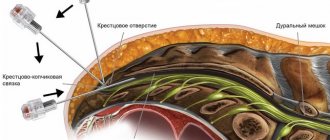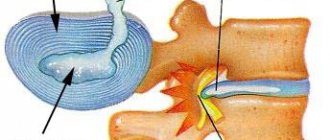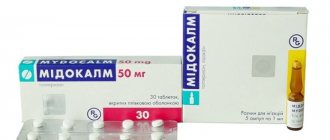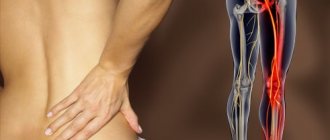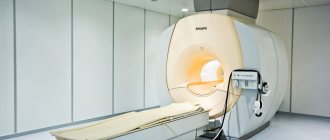How to choose injections for back and lower back pain
The information below is not a guide to action, does not replace medical advice, and is intended for general guidance only. All medications must be taken only as prescribed by a specialist, under medical supervision. Self-medication is unacceptable and can lead to serious harm to health.
Kazieva Aminat Ziyavovna
Neurologist
Rostov State Medical University
Experience since 2012
It is safer and more effective to consult a good doctor - an accurate diagnosis and correctly prescribed treatment will help you get rid of back pain with a greater likelihood than self-medication. Remember that many medications have side effects and should therefore only be used when indicated. No article or video about what injections to give for back pain can replace an in-person appointment and consultation with a doctor.
Apizartron
Ointment for the lower back "Apizartron" contains bee venom and provides excellent warmth. The active ingredients of the ointment are methyl salicylate (relieves inflammation), allyl isothiocyanate (warms tissues, improving blood circulation), bee venom (analgeses, reduces inflammation, fights infection). Many patients consider this ointment for the lower back to be one of the most effective. But keep in mind that Apizartron ointment can cause an allergic reaction, so we recommend performing a skin test before starting treatment.
Apizartron
Esparma, Germany
Diseases of the musculoskeletal system (osteoarthrosis, rheumatic lesions of soft tissues).
Arthralgia (including rheumatic joint diseases). Myalgia (including those associated with overexertion. Neuralgia (including neuritis, sciatica). Peripheral circulation disorders. Pain syndrome with soft lesions of muscles, tendons, ligaments, bruises and sprains. To warm up the muscles before and during sports loads from 176
1308
- Like
- Write a review
Nonsteroidal anti-inflammatory drugs (NSAIDs) for back pain
Nonsteroidal anti-inflammatory drugs are a group of drugs that have an analgesic effect. The mechanism of action of NSAIDs is the ability of these drugs to block inflammation by preventing the formation of the enzyme cyclooxygenase. Cyclooxygenase, in turn, is involved in the synthesis of prostaglandins - substances that support inflammation. Due to this ability, NSAIDs reduce inflammation, relieve inflammatory swelling, and have antipyretic and analgesic effects. For this reason, NSAIDs are often used in injections as an analgesic for back pain - as symptomatic and pathogenetic therapy.
NSAIDs have serious side effects because prostaglandins have other functions in the body that are not related to inflammation. The most common consequence of taking NSAIDs is drug-induced gastritis or drug-induced stomach ulcers. Gastrointestinal bleeding is possible. The most serious side effect of NSAIDs is chronic renal failure - long-term use of non-steroidal anti-inflammatory drugs leads to kidney failure. Treatment for chronic renal failure consists of hemodialysis or kidney transplantation. For this reason, NSAIDs are contraindicated in persons with peptic ulcers/gastritis or kidney disease.
NSAIDs are recommended to be used only as an injection for severe back pain , in case of a sharp exacerbation of a herniated disc, in case of injury, intercostal neuralgia. If the pain is tolerable, it is better to use local remedies - ointments, gels, patches containing NSAIDs. In this form, they have only a local effect and do not lead to serious side effects on the gastrointestinal tract and kidneys.
The most common drugs from the NSAID group
- Ketorol (ketoprofen);
- Xefocam;
- Texamen;
- Diclofenac;
- Meloxicam;
- Dexalgin.
Where to get injections of B vitamins in St. Petersburg?
MRI and ultrasound center RIORIT
Area:
Kalininsky
Metro:
metro station Grazhdansky Prospekt, metro station Devyatkino, metro station Prospekt Prosveshcheniya
Address:
St. Petersburg, Kalininsky district, st. Rustaveli, 66 lit. G
Telephone:
Equipment:
Siemens, open type
Schedule:
Around the clock
Vitamin B deficiency
Vitamin B9 (folic acid) is a water-soluble vitamin. It is especially necessary for women during pregnancy for the development of the fetus. A normal amount of this vitamin reduces the possibility of intrauterine defects.
read more
Vitamin B deficiency
Vitamin B1 (thiamine) is a water-soluble vitamin, one of the most famous of the entire B group. Vitamin B1 deficiency is quite common because it is heavily consumed by the body. This is an essential vitamin that is involved in energy metabolism. It normalizes the activity of the central nervous, cardiovascular and endocrine systems.
read more
Vitamin B deficiency
Vitamin B6 (pyridoxine) is a water-soluble vitamin. In pharmacies it is often sold in the form of ampoules with a solution. The fact is that this vitamin, like vitamins B1, B12, C, can be isolated and made into a solution. It is worth noting that this vitamin is not synthesized by the body; it comes only from the outside.
read more
Muscle relaxants for back pain
Pathological muscle spasm is of great importance in the development of spinal diseases such as ankylosing spondylitis and other spondyloarthritis, spinal osteochondrosis, intervertebral disc herniation, multiple sclerosis and other neurological diseases. By relaxing the back muscles, peripherally acting muscle relaxants help relieve back pain caused by muscle spasms. They also have a weak local anesthetic effect, help improve blood circulation, and increase the range of motion in diseased segments of the spine. The analgesic effect of muscle relaxants is enhanced in combination with NSAIDs, which allows their use in the treatment of acute and chronic back pain as pathogenetic and symptomatic therapy.
Kazieva Aminat Ziyavovna
Neurologist
Rostov State Medical University
Experience since 2012
Side effects of muscle relaxants are determined by the mechanisms of their action - general weakness, dizziness, and increased fatigue are most often observed. Allergic reactions, cardiac rhythm and conduction disturbances are possible.
The most common muscle relaxants for treating back pain are:
- Tolperisone (Mydocalm);
- Tizanidine (Sirdalud);
- Baclofen (Baclosan);
Hydroxyzine (Atarax) is an antihistamine that is also a weak sedative, tranquilizer, analgesic and muscle relaxant. It is used for the same indications as peripheral muscle relaxants, relieving back pain. The tranquilizing and sedative effect allows the drug to be used to eliminate anxiety, phobias, anxiety and irritability. Due to these effects, Atarax is often used for diseases of the musculoskeletal system.
Muscle relaxants
Quite often, back pain occurs as a consequence of muscle spasms. There are usually two different types based on etiology:
- spasticity resulting from damage to brain activity;
- muscle pain and spasms due to musculoskeletal disorders.
Injections of muscle relaxants are prescribed to enhance the effect of NSAIDs and steroid medications. Injections should be carried out in full compliance with the dosage and administration rules.
Mydocalm
Relaxes the spinal muscles, blocks nerve endings and relieves back and lower back pain. Contains an active substance - tolperisone, which provides a local anesthetic effect. May cause allergies in patients intolerant to lidocaine.
Atarax
This drug is a piperazine derivative. Intramuscular injections relax the vertebral and smooth muscles of the back with a moderate effect on the gastrointestinal tract.
Contraindications: pregnancy, hypersensitivity to components, arrhythmia and renal failure.
Baclofen (Baklosan)
The main therapeutic component is baclofen, which helps reduce the excitability of sensitive nerve endings and impulses, relieving pain in the lower back and back. Contains contraindications for patients with Parkinson's disease, muscle cramps, epilepsy and intolerance to the components.
Hydroxyzine
The active ingredient is hydroxyzine. Injections help relieve muscle tone in the lower back and neurotic pain in the back. Its effects are similar to Atarax, since it is a piperazine derivative. Should be used with caution in patients with renal failure.
Tizanidine
The main substance in the composition is tizanidine. Reduces the aggravated tone of the skeletal muscles, removes spasms in the back, reduces muscle resistance during inert movements, and increases the power of free contractions. May have side effects at higher doses.
Sirdalud
Derived from tizanidine. Relieves various muscle tones, lower back pain of various etiologies, providing an analgesic effect.
Steroid drugs for back pain
Steroid drugs are synthetic analogues of adrenal hormones that have a powerful anti-inflammatory effect that significantly exceeds that of NSAIDs. Inflammatory processes in diseases of the spine are the main source of pain. Taking and prescribing steroid hormones as an analgesic is justified only for very severe pain, since this group of drugs has significant side effects.
With prolonged and uncontrolled use, steroid drugs can cause stomach ulcers, gastric bleeding, hormonal disorders, increased blood pressure, Itsenko-Cushing syndrome (obesity, excess hair growth, high blood pressure, infertility), decreased immunity with the occurrence of secondary infections. Possible atrophy of the adrenal cortex, muscle atrophy at the injection site, osteoporosis with pathological fractures, thromboembolism, diabetes mellitus. It is strictly forbidden to use hormonal drugs without a doctor’s prescription and supervision.
Most often, steroids are part of a “cocktail” used for paravertebral or epidural blockades for very severe back pain - the effect after the injection occurs instantly and lasts several days. However, this treatment method is symptomatic therapy and does not affect the outcome and recovery time.
Most Commonly Used Steroid Drugs for Back Pain
- Betamethasone (Flosteron, Diprospan);
- Hydrocortisone;
- Prednisolone;
- Kenalog.
Drugs used for therapeutic blockades
First, let's look at the most commonly used local anesthetics.
"Novocaine"
Can be injected into nerves and tissues, relieves pain and relieves spasms. In the pathological focus, strong irritation occurs and peripheral innervation is switched off. The drug improves tissue trophism, as well as:
- reduces the permeability of vascular walls;
- acts as an antiseptic and bacteriostatic;
- increases resistance to allergens;
- evens out vascular tone;
- improves nerve trophism.
It is considered the safest means of pain suppression, characterized by a minimum of side effects. Has a certain degree of toxicity.
"Lidocaine"
A local anesthetic that provides a more intense and long-lasting effect compared to Novocain. It is used in the form of hydrochloride. Blocks voltage-gated sodium channels, which stops the generation of impulses in nerve endings and blocks the conduction of impulses along nerves. Blocks not only pain impulses, but also others. Dilates blood vessels and has no local irritating effect. A few minutes after the administration of Lidocaine, the pain disappears and the muscles relax. Toxicity is lower than that of Novocain.
"Bupivacaine"
Amide drug. Its effect develops slowly, but lasts for a long time. This is a drug approximately 16 times more powerful than Novocaine. The entire group of amide anesthetics is more stable compared to ester anesthetics (for example, Novocain). Their long-lasting effect is due to the fact that they have a longer half-life. This is due to the fact that drugs are processed not by plasma, but by the liver. Bupivacaine prevents the pain impulse from spreading along the nerves by blocking sodium channels in the neuron membrane. The blockade is sequential, depending on the size of the nerve fibers (small ones are more sensitive compared to large ones), the degree of activation (a higher frequency of impulses opens more channels for blocking), and the degree of myelination (fibers with a myelin sheath are blocked better). The effect of the procedure occurs within 5-10 minutes.
Now let's move on to the most popular glucocorticosteroids. Drugs in this group are designed to enhance the effectiveness of the blockade, relieve inflammation and allergic reactions. Can also be used independently.
"Hydrocortisone"
Belongs to a group of drugs with a short duration of action. Contains artificial hormones that are similar to those produced by the adrenal glands. It is used to treat heel spurs with a course of 3-5 injections. The active substance of the drug accumulates in tissues, relieving inflammation. The main advantage is low price. However, it loses to Diprospan in terms of effectiveness.
When injected into joints together with Lidocaine, the effect develops within 24 hours and lasts up to several weeks. Able to increase blood pressure while simultaneously reducing the concentration of lymphocytes. Thanks to the first, the volume of blood circulation increases, and the second, the intensity of the immune response decreases. The drug is suitable for neurological blockades. For peri- or intra-articular blockades, it is necessary to mix the microcrystalline suspension with a local anesthetic to prevent necrosis.
"Dexamethasone"
Long-acting glucocorticosteroid. One of the most powerful drugs. It has a pronounced anti-inflammatory, antiallergic, immunosuppressive and desensitizing effect. It works especially well when used together with an anesthetic for degenerative pathologies. Reduces inadequate response to anesthetic drugs. Acts quickly, suitable for blockades of soft tissues and joints. Compared to Hydrocortisone, Dexamethasone is 25-30 times more active. There are no known cases of necrosis with its use; it has little effect on electrolyte metabolism.
"Depo-Medrol"
Methylprednisolone acetate is a long-acting form of methylprednisolone. This is due to poorer solubility and lower metabolization activity. Used for blockades of soft tissues and joints. For epidural blocks - with caution, because it can provoke inflammation of the arachnoid membrane.
Used to treat all joints, with the exception of those that are difficult to reach and do not have a synovial cavity. When injecting into the hip joint, it is necessary to avoid entering large vessels. Injections into the tissue surrounding the joint may have little or no effect. If there is no positive effect from the first injection, the procedure is not repeated.
"Diprospan"
A drug based on betamethasone. Used to treat heel spurs. Provides rapid analgesic and anti-inflammatory effect. Relieves allergic reactions. Usually it allows you to cure a spur in 1-2 sessions. A significant drawback is the destructive effect on the adrenal glands and pituitary gland. However, the likelihood of complications in this drug is sharply reduced compared to analogues. It differs from other similar drugs in its microcrystalline structure. Can be used for epidural blockades, as well as blockades of spinal nerves, muscles, etc. It is effective for destructive-dystrophic diseases of the spine, in particular the lumbar region.
Chondroprotectors for back pain
Chondroprotectors are drugs that have the ability to stimulate metabolism in cartilage and protect it from damage and premature wear. The mechanism of action of chondroprotectors is the ability to trigger the synthesis of collagen - the main protein of connective tissue, responsible for the strength, elasticity and flexibility of joints, bone tissue, intervertebral discs, ligaments and tendons. Taking chondroprotectors allows you to slow down the destruction of cartilage, reverse degenerative processes, and restore the structure of connective tissue. Thanks to these effects, chondroprotective drugs relieve pain, reduce inflammation, and improve spinal mobility.
Kazieva Aminat Ziyavovna
Neurologist
Rostov State Medical University
Experience since 2012
Most often, chondroprotectors are prescribed orally in the form of tablets and capsules. There are injectable forms of this group of drugs that are administered intramuscularly for back pain caused by degenerative-dystrophic diseases of the spine (osteochondrosis of the spine, intervertebral hernia, spondyloarthritis and spondyloarthrosis, spondylosis). Chondroprotectors are usually well tolerated by patients, do not have significant side effects, and are etiotropic, pathogenetic and symptomatic therapy. The disadvantage is that to obtain any significant effect, long and expensive repeated courses of treatment are required.
Chondroprotective drugs for the treatment of back pain:
- Chondroitin sulfate (Chondrolone);
- Alflutop.
Indications for therapeutic blockade
- pain in the neck, back;
- osteochondrosis;
- neuralgia, neuritis;
- pain in the spine due to intervertebral hernia;
- rheumatism;
- osteoarthritis;
- pain in the postoperative period;
- phantom pain;
- Minière's syndrome;
- neuropathy;
- spasticity;
- amputation pain;
- pain and spasticity after a stroke;
- radiculitis;
- migraine;
- sciatica;
- tunnel syndrome.
Vitamin preparations of group B
The nature of back pain is often associated with neurological disorders - numbness, crawling sensation, burning sensation on the skin, sensory disturbances, and the pain itself occurs as a result of irritation or pinching of the spinal cord roots. This is especially true for chronic back pain. Acute pain syndrome also occurs as a result of impaired perception of nerve impulses from inflamed or damaged muscles, ligaments, and tendons. B vitamins (B1, B6, B12) are of great importance for the normal function of the nervous system in general and the peripheral nervous system in particular. Thus, a deficiency of these vitamins leads to neuropathies and neuritis.
Thiamine (vitamin B1) plays an important role in nerve regeneration, ensures redox reactions and metabolism in nervous tissue, and regulates the supply of nutrients and biologically active substances. Pyridoxine (vitamin B6) has antioxidant properties and provides the function of transport proteins that carry nutrients and biologically active substances from neurons to nerve fibers. Vitamin B12 (cobalamin) takes part in biochemical processes in nerve tissues, stimulates the synthesis of myelin (a substance that insulates nerve fibers).
Kazieva Aminat Ziyavovna
Neurologist
Rostov State Medical University
Experience since 2012
B complex vitamins in the form of injections are often used as injections for back pain as so-called neurotropic therapy. A course of such drugs has an analgesic effect, stimulates metabolism and regeneration in the affected nerves, and improves the functional state of the entire nervous system as a whole. The effectiveness of the vitamin B complex for back pain has been proven in experiments - the joint administration of this group of drugs with NSAIDs and muscle relaxants allows you to reduce the dose and, accordingly, the likelihood of developing side effects of the latter.
When used correctly, B vitamins are well tolerated by patients and have virtually no serious side effects. It is important to remember that some vitamin B complex injections contain lidocaine; for pain relief, the injection is quite painful. If the patient has an allergy or individual intolerance to lidocaine, it is necessary to choose a drug that does not contain it.
There are many different complex drugs of group B on the market with different names , which are used as injections for back pain (as pathogenetic and symptomatic therapy):
- Milgamma
- Combilipen
- Neurobion
- Trigamma
Vitamin B12 in neurology
A person should especially monitor the level of vitamin B12 in his body. The fact is that it is an important metabolic substrate for various biochemical reactions in the body. For example, this vitamin serves for the synthesis of red blood cells, enzymes, methionine acid, nucleic acids, and activation of blood clotting. The body takes vitamin B12 from food, and some of it is also produced by special bacteria in the intestines. The body's daily need for this vitamin is very small, but it is essential for the process of hematopoiesis and the healthy functioning of the central nervous system. B12 has the ability to accumulate in the human liver in reserve, so its deficiency is a very serious symptom of diseases such as anemia, damage to nerve tissue or polyneuropathy, stroke due to excess homocysteine in the blood. If a person, for one reason or another, begins to lack vitamin B12, he suffers from systematic weakness, shortness of breath, loss of sensation in the limbs, a limping gait, “cotton leg” syndrome, memory deteriorates, and chilliness in the arms and legs may occur. Often the tongue is an indicator of a lack of vitamin B12 in the body. In a patient in such a situation, the doctor may observe a smooth, bright crimson, varnished tongue with atrophy of the papillae. In neurology, B12 deficiency leads to the fact that the nerve roots of the spine do not receive enough nutrition, and degenerative changes occur in the myelin sheath of the nerves. Due to a lack of vitamin, the membrane is poorly formed, the nerves begin to transmit information incorrectly, that is, they conduct impulses poorly, as a result of which a person loses sensitivity in the legs and arms. The consequences of an acute lack of vitamin B12 can lead to the development of paresis and complete paralysis. These are of course extremes, but still... Insufficient levels of vitamin B12 can also lead to stroke. This occurs due to excess levels of homocysteine in the blood. As a result, the inner linings of the arterial vessels begin to collapse, and cholesterol begins to integrate into these lacunae, forming an atherosclerotic plaque. As a result of this, blockage of first small and then large vessels occurs, thrombus formation and, as a final result, myocardial infarction or stroke.
Previous Next
Paravertebral blockade
This procedure is performed only by a specialist on an outpatient basis, due to the risk of damage to the nerve trunks (paravertebral block) and the spinal cord (paravertebral block). The purpose of the procedure is to eliminate back pain by introducing a solution of medications (local anesthetics, steroid hormones) into the epidural space of the spinal cord. This achieves an immediate analgesic effect, which helps even with unbearable pain in the back, lower back and lower extremities (symptomatic and pathogenetic therapy of back pain).
This procedure, if performed incorrectly, can lead to serious complications. Therefore, this treatment method is used only for severe and unbearable pain. In all other cases, it is better to limit yourself to safer methods.
For paravertebral blockades, it is permissible to use a more complex combination of drugs - NSAIDs, glucocorticosteroids, local anesthetics, chondroprotectors, vitamin B complex. The injection is performed through the muscles running along the spine until it touches the transverse process of the vertebra, 2 cm away from the center of the spine. The roots of the spinal cord pass in close proximity to the tip of the needle, where the drug is injected. The procedure can be performed under the control of an ultrasound machine.
Vitamin B6 and carpal tunnel syndrome
Sometimes it happens that a person wakes up with a feeling of numbness in the fingers. Neurologists call this condition tunnel syndrome. The cause of this disease lies in the wrist area, where there is a special canal (tunnel) through which the median nerve passes. It innervates the second, first and third fingers of the hand, and thanks to this nerve, these three fingers sense and carry out movements. In people with a certain type of activity, when the load is placed on the hand or the work is accompanied by vibration, the transmission of impulses along the median nerve is disrupted, and the fingers become numb as a result. To treat carpal tunnel syndrome, the doctor may prescribe a course of vitamin B6 injections and physical therapy. Using a needle, a drug containing B6 is injected directly into the tunnel, as a result of which inflammation, numbness and pain go away. Typically, for carpal tunnel syndrome, 3 to 5 injections are given, and such therapy has a very long-lasting effect.
Triad injections
Troychatka is often called a mixture of three drugs - Analgin, Diphenhydramine and Papaverine. However, it is more correct to call this “cocktail” a lytic mixture, since its use leads to a rapid decrease in temperature during fever. Triplet is often suggested to be used for back pain, but its use in this capacity is not only not justified, but also ineffective and unsafe. Firstly, Analgin is recognized throughout the world as a highly toxic drug and has not been used in practice for a long time. Secondly, with frequent use of Analgin, serious side effects are possible, including impaired hematopoiesis and aplastic anemia. Thirdly, in terms of pain relief power, triad is much inferior to other drugs from the NSAID group.
You should not take recommendations from non-specialists, as well as articles on the Internet written by people who do not have a medical education as a guide to action (texts with headings like “ list of the best injections for back and lower back pain ” should be skipped immediately). Pain is a nonspecific symptom that can occur in a variety of diseases. Back pain can be a sign not only of osteochondrosis, but also of serious diseases - spinal cord tumors, spinal tuberculosis, multiple sclerosis. Modern medicine makes it possible to clarify and determine the cause of pain in just one MRI study. And a consultation with a good doctor and the treatment he prescribes will be much more effective than weeks or even months of back pain.
Nayatoks
This is a Vietnamese drug based on cobra venom. In addition, it contains camphor, methyl salicylate and eucalyptus oil, which irritate the skin locally and dilate blood vessels, which improves blood circulation. Nayatox ointment is excellent for lower back pain. The drug has a strong smell, but this is not a problem since Nayatox is used once a day at night. If you look for reviews on the Internet about this ointment for the lower back, there are many of them and most are positive. “Nayatox” warms gently, without burning, and at the same time relieves pain and discomfort in the lower back.
Nayatoks
MEKOFAR, Vietnam
Pain syndrome in diseases of the musculoskeletal system: - arthritis of various etiologies;
- neuralgia; - myalgia; - sciatica; - radiculitis. from 100
427
- Like
- Write a review
Blockade in the spine: consequences and their prevention
Complications occur only in 0.5% of cases. These may include unexpected reactions to medications such as dizziness, vomiting, or increased heart rate. Damage to blood vessels at the injection point with the formation of a hematoma, infection and bleeding is also possible. Allergic reactions are possible. For preventive purposes, additional injections are given, and a test test is performed to prevent allergies. Our center has all the conditions for safely performing therapeutic blockades that will relieve you of debilitating pain for a long time. You don't have to worry about possible consequences or poor quality pain relief.
We employ high-level specialists with extensive experience, making patients feel comfortable and confident. If necessary, you will be prescribed one or more intra-articular injection procedures and a drug will be selected based on the indications.
Finalgon
“Finalgon” is a combination drug with a good warming effect, which contains nonivamide and nicoboxil. “Finalgon” dilates blood vessels and anesthetizes, so when applied to the affected area, blood circulation and local metabolism improve, the temperature of the body area increases - all this significantly reduces pain. Finalgon ointment is usually prescribed for lower back pain caused by muscle spasms. Many patients respond very well to Finalgon, although some doctors are confident that its effect is largely distracting and not therapeutic.
Finalgon
Boehringer Ingelheim, Germany
- arthritis;
- arthralgia and myalgia of rheumatic origin; - sports injuries, bruises and damage to the ligamentous apparatus; - myalgia caused by excessive physical activity; - lumbago; - neuritis; - sciatica; - bursitis and tendovaginitis; - acute nonspecific pain in the lower back; - for preliminary “warming up” of muscles before physical exercises, sports competitions; - as part of complex vasodilator therapy for peripheral circulatory disorders. from 246
5.0 1 review
849
- Like
- Write a review
How does a spinal block block work?
First, the doctor examines the patient and, based on the examination and examination data, selects the optimal method. Then the injection site is disinfected, and local anesthesia is performed if necessary. Once the anesthesia has taken effect, the medicine itself is administered. Since the disease can affect any part, the injection is given in the lumbar region, shoulder blades or neck, that is, in the place where the pain is localized. At the end of the procedure, the injection site is once again treated with an antiseptic, and a sterile bandage is applied. To consolidate the effect, the patient remains lying on the couch for at least an hour.
Injections for disc herniation
Disc injections should not be given if other injections have not been successful. In a discogram, contrast is injected into the disc so that the disc can be seen on x-rays or other tests.
injections>
Typically, the injection uses a local anesthetic along with a steroid and can be done with EMG or MRI guidance. Standard practice is to try physical therapy and anti-inflammatory medications first, and only use a steroid injection when other treatments have failed.
Advantages
- fast, complete and long-lasting pain relief;
- additional therapeutic effect due to the acceleration of recovery processes;
- possibility of repeated use;
- minimum of adverse reactions.
For tonic syndromes caused by muscle tension, blockades can relieve discomfort for several months or even years. For more serious diseases, anti-inflammatory and hormonal agents are added to the anesthetics, as well as chondroprotectors for cartilage regeneration. When introduced into a sore spot, they are much more active than droppers, tablets or ointments. Therefore, therapeutic blockades in neurology are much more effective than pharmaceutical drugs and physiotherapy.
